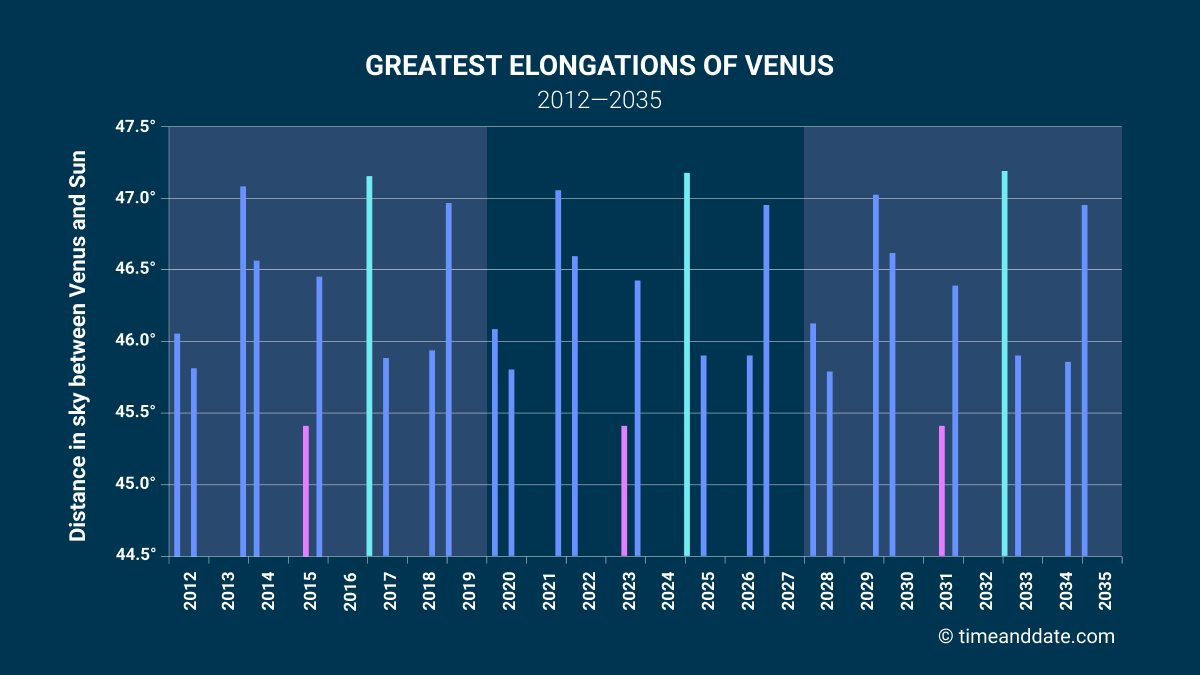June 4, 2023: Venus at Farthest Distance from Sun in Sky
Twice every 19 months, Venus reaches its farthest point from the Sun in the sky. But on June 4, its maximum distance will be slightly less than usual.


This chart shows the maximum separations (greatest elongations east and west) between Venus and the Sun over 24 years. The three smallest separations are highlighted in pink, the three largest in green. We can see how a pattern repeats every 8 years.
©timeanddate.com
The Evening and Morning Star
Venus orbits the Sun more closely than Earth does. As a result, when we see the planet in the sky, it is never far from the Sun: we normally see it after sunset or before sunrise.
At its best, Venus is easily the brightest and most dazzling planet, and is affectionately known as either the evening star or the morning star.
Venus shines as the evening star for around nine months. It then crosses swiftly in front of the Sun, and becomes the morning star. Nine months later, it passes more slowly behind the Sun, and becomes the evening star once again.
Find and track Venus with our Night Sky Map
The entire cycle—which astronomers call its synodic period—takes 583.92 days, or about 19 months.
How Far Can Venus Stray from the Sun?
The distance between the Sun and a planet—as seen from Earth—is called its elongation. It is measured in degrees.
A handy guide to measuring the sky
The maximum distance that Venus reaches from the Sun in the evening sky is referred to as its greatest elongation east. (The word “east” refers to Venus being east of the Sun’s position as they travel from east to west across the sky. However, Venus shines in the western sky after sunset.)
Similarly, the peak distance from the Sun that Venus reaches in the morning sky is called its greatest elongation west.
In all cases, Venus’s greatest elongation is 46° or so.
June 2023: Greatest Elongation East
Venus has been shining as the evening star since the end of 2022. Each evening, it has been appearing farther and farther from the Sun, and it reaches greatest elongation east on June 4.
Astronomy calendar: sights to see


This view from our Interactive Night Sky Map shows Venus at greatest elongation east on June 4, as seen from New York City. Reddish Mars lies just above and to the left of Venus, in the constellation of Cancer.
©timeanddate
Venus has been easy to spot in the evening sky all year, but its greatest elongation provides a good excuse to head outside and look to the west.
Interestingly, greatest elongation does not equal maximum brightness. Venus will be at its brightest on July 9, when its orbit around the Sun brings it closer to Earth.
Distance, brightness, and size of planets
In addition, greatest elongation is not when Venus is at its highest in the sky at sunset. There are two other factors that affect the altitude of Venus above the horizon: the observer’s latitude, and the way the direction of Earth’s tilt changes over the course of the year.
Altitude & azimuth: the horizontal coordinate system
Never the Same Twice
The movements of planets across the sky never repeat precisely. Planetary orbits are not perfect circles, plus they are tilted in slightly different ways.
The chart at the top of this page shows all the greatest elongations of Venus between 2012 and 2035. The events come in pairs: a greatest elongation east is quickly followed, 4½ months later, by a greatest elongation west; there is then a 14½-month wait until the next greatest elongation east.
We can see from the chart how greatest elongations of Venus vary by a couple of degrees. The greatest elongation east on June 4, 2023, is relatively small: 45.40°.
By contrast, Venus’s next greatest elongation east—on January 10, 2025—will be relatively large: 47.17°.
Feeling the Rhythm
The above chart also reveals a pattern where almost identical greatest elongations repeat every 8 years.
The three largest and three smallest greatest elongations have been highlighted in the chart. They are also given in the tables below—within each table, note the 8-year gap between the dates.
Greatest Elongations of Venus, 2012–2035
The Three Largest...
| Date | Distance | |
|---|---|---|
| January 12, 2017 | 47.15° | |
| January 10, 2025 | 47.17° | |
| January 7, 2033 | 47.19° |
...and the Three Smallest
| Date | Distance | |
|---|---|---|
| June 6, 2015 | 45.39° | |
| June 4, 2023 | 45.40° | |
| June 2, 2031 | 45.40° |
Angular separation of Venus and the Sun at greatest elongation.
Sources: timeanddate.com, JPL Ephemeris DE430
Why 8 Years?
The reason for this repeating cycle is that Venus’s synodic period and Earth’s orbital period fall into near-perfect alignment every 8 years. In other words, Venus and Earth return to roughly the same points in their orbits around the Sun, producing similar greatest elongations of Venus.
To recap, the synodic period of Venus is 583.92 days. Earth’s sidereal year—the period of its orbit around the Sun with respect to the stars—is 365.26 days.
- 8 Earth sidereal years = 8 x 365.26 days = 2922.08 days
- 5 Venus synodic periods = 5 x 583.92 days = 2919.60 days
- Difference = 2.48 days
This means that greatest elongations of Venus repeat every 8 years, but about 2½ days earlier each time.